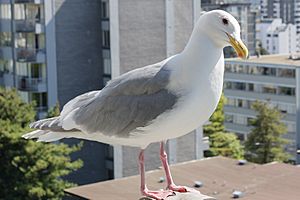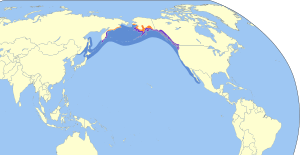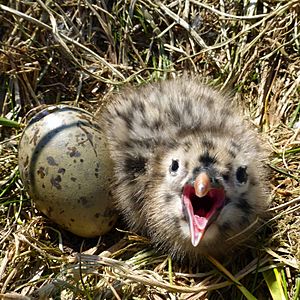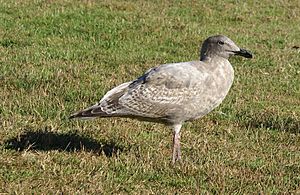Glaucous-winged gull facts for kids
The glaucous-winged gull (Larus glaucescens) is a large gull with a white head. Its name comes from the Latin word Larus, which means "gull." The word glaucescens is New Latin for "glaucous," which describes the grey color of its wings. These gulls are common along the Pacific coast of North America.
Quick facts for kids Glaucous-winged gull |
|
|---|---|
 |
|
| Conservation status | |
| Scientific classification | |
| Genus: |
Larus
|
| Species: |
glaucescens
|
 |
|
Contents
Where Glaucous-winged Gulls Live
Glaucous-winged gulls usually stay close to the ocean. They live all year round along the western coast from Alaska down to Washington. You can also find them in the Seattle area.
In the summer, they travel to breed along the northwest coast of Alaska and in the Russian Far East. When winter comes, these gulls fly south. They can be seen along the coasts of California, Oregon, Baja California, Baja California Sur, and Sonora.
Sometimes, glaucous-winged gulls mix with other types of gulls. This can make them a bit tricky to identify.
How Long Glaucous-winged Gulls Live
Most glaucous-winged gulls live for about 15 years. However, some live much longer than that! One gull in British Columbia lived for over 21 years. Another in Washington lived for at least 22 years and 9 months. The longest known life for a glaucous-winged gull is over 37 years. This bird was tagged as a chick in British Columbia.
What Glaucous-winged Gulls Look Like

This gull is a big bird. It is similar in size to a herring gull or a western gull. Glaucous-winged gulls are about 50 to 68 centimeters (20 to 27 inches) long. Their wings can spread out 120 to 150 centimeters (47 to 59 inches) wide. They usually weigh around 1 kilogram (2.2 pounds).
They have a white head, neck, chest, and belly. Their tail is also white. Their wings and back are a pearly-grey color. The very tips of their wings are white. Their legs are pink, and their beak is yellow. The beak has a small red spot near the end. This spot helps chicks know where to peck for food.
In winter, their head and neck can look a bit dusty or darker. Young gulls are brown or grey with black beaks. It takes them about four years to get their full adult colors.
Life Cycle and Habits
Glaucous-winged gulls build their nests in the summer. Each pair of gulls usually has two or three chicks. The young chicks learn to fly, or "fledge," when they are about six weeks old.
These gulls find their food along the coast. They often eat dead or weak animals, fish, and mussels. They also eat scraps of food. In cities, they are known for taking food from people. They might even open garbage bags to find something to eat!
Their call sounds like a low "kak-kak-kak" or "wow." They can also make a higher-pitched wailing sound.
Images for kids
See also
 In Spanish: Gaviota de Bering para niños
In Spanish: Gaviota de Bering para niños





